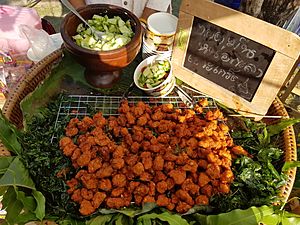Alpinia nigra facts for kids
Quick facts for kids Alpinia nigra |
|
|---|---|
| Scientific classification | |
| Genus: |
Alpinia
|
| Species: |
nigra
|
Alpinia nigra is a medium-sized herb that belongs to the ginger family. It is also known by other names like Alpinia allughas and Zingiber nigrum.
The underground stem, called a rhizome, is very popular in many Asian cultures. People use it for both cooking and medicine. In some Asian communities, it is even a regular part of their meals, often eaten with rice.
This plant naturally grows in Southeast Asia. You can find it in countries like Bhutan, China, India, Thailand, Bangladesh, Burma, and Sri Lanka. In India, it grows mostly in the hills and along rivers in states such as Assam, Mizoram, and Tripura.
What Does Alpinia nigra Look Like?
Alpinia nigra is a biennial herbaceous plant. This means it lives for two years and has soft, green stems instead of woody ones. It has a special underground stem called a rhizome.
The plant has simple, wide leaves. These leaves are protected by colorful, leaf-like parts called bracts. Its flowers grow in clusters at the top of the stem, known as inflorescences.
The soft, leafy stem can grow quite tall, reaching about 1.5 to 3 meters (about 5 to 10 feet) high. The leaves are long and pointed at the end. They are shaped like a spear and are about 7–9 cm (3–3.5 inches) wide and 20–40 cm (8–16 inches) long.
The fruit of Alpinia nigra is a berry that holds many seeds. When the fruit is young, its outer skin (called the pericarp) is thin and green. As it gets older, it turns black and becomes brittle.
How People Use Alpinia nigra
Alpinia nigra is used in many ways, especially in cooking and traditional medicine.
In Food
The soft inner part of the plant's stems is cooked as a vegetable. It is also added to curry dishes to give them a special flavor. The root is used for seasoning food.
In a place called Amphoe Pak Kret in Thailand, this plant is mixed into a popular dish called Thot man. These are Thai fishcakes, and this specific version is a local specialty.
Among the Boro people in Assam, India, the inner stem is mixed with chicken and fried. This creates a much-loved dish. They also use the plant's fragrant leaves to wrap fish before baking, roasting, or steaming it.
In Medicine
The rhizome of Alpinia nigra is used in traditional medicine. It can act as a tonic (to make you feel stronger), a diuretic (to help your body get rid of water), and an expectorant (to help with coughs). It can also help with your appetite and reduce pain. Some people use it to help treat bronchitis.
In many communities, the root is crushed and mixed with rice whisky. This mixture is then put on the skin to treat fungal infections like ringworm and melasma.
Boiled green roots are used to help with flatulence (gas) or indigestion. Some people take an extract from the root three times a day to treat stomach ulcers. The Chakmas use it twice a day for jaundice. Studies on mice have also shown that it can help reduce inflammation and pain.
The rhizome, whether cooked or raw, has been a traditional remedy for intestinal infections among the Mizo tribes in northeast India. Research has shown that an extract from the plant was very effective against a type of trematode worm called Fasciolopsis buski.


